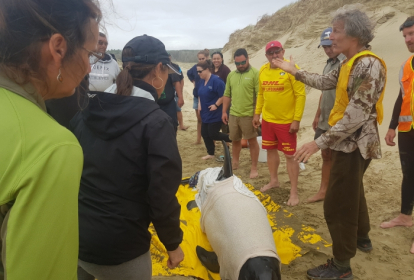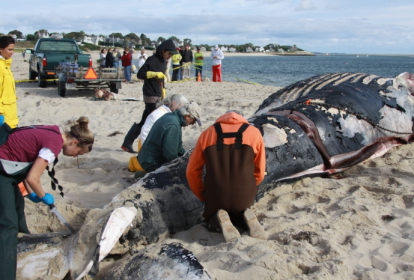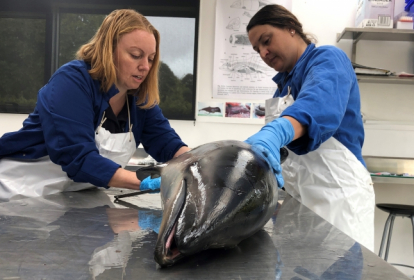If you see a stranded cetacean please contact your local strandings network
There are reports of cetaceans stranding since records began and it is a potential issue for every country with a coastline. Stranding occurs for two reasons – natural factors including age and disease, and human-related factors including bycatch, vessel collisions and environmental degradation. Natural and human factors can also interact to cause stranding. Animals may strand alive on the beach, or die at sea and be carried on to land by the currents (often referred to as beachcast).
The most obvious and immediate issue is how to deal with live, stranded animals. Successful re-floating of some smaller cetaceans can be possible when conducted by trained responders in the right conditions. Even for dolphins and porpoises however, a stranding is often terminal. Out of the water, the inability to regulate body temperature, and unnatural weight and pressure on an animal’s organs can cause severe internal injury or death. The prognosis for larger whales is therefore particularly poor.
Even when the terrain and sea conditions seem suitable for re-floating, an animal may have unseen internal injuries that would result in a prolonged, possibly painful death at sea. Such attempts can also result in traumatic re-stranding.
Any re-floating attempt should be carried out by trained responders experienced in cetacean health and welfare assessment. Even severely injured cetaceans can look healthy to the untrained eye, and all cetaceans, especially large ones, can be extremely dangerous to handle.
Many countries have regional or national strandings teams. The aspiration of these teams is to return a healthy animal to the sea, but where this is impossible, post mortems (known as necropsies) are conducted to learn more about the animal and why it may have stranded. Necropsies are also conducted wherever possible on animals that are already dead when they strand.
The IWC Strandings Initiative
In 2016, the IWC endorsed a new initiative aiming to share international strandings expertise and information, establish best practice guidelines, and provide emergency response training. The ultimate goal of this international programme is building global capability in strandings response, research and data collection.
Using the successful blueprint of the IWC Entanglement Response Network, the Strandings Initiative has three core components: a Steering Group to manage the initiative, a multi-disciplinary Expert Panel to provide specialist advice, and a Strandings Co-ordinator who brings technical expertise and leads the work programme.
Click here to read more about the IWC Strandings Initiative.
Euthanising Stranded Animals
Euthanasia can sometimes be the most humane response to a stranded cetacean, but this is also an extremely challenging task. With small cetaceans, chemical euthanasia is similar to standard veterinary euthanasia of companion animals (cats and dogs) and can be done humanely. However, with larger cetaceans, the size of the animal necessitates large quantities of euthanasia agent and a large, advanced system of delivery which cannot be deployed safely in surf or with an agitated whale.
A number of countries have developed ballistics-based protocols for large whale euthanasia. This may sound surprising, but precision gunshot or positioning of explosive charges can result in a death which is as quick and painless as possible.
In 2013, an IWC workshop brought together experts from around the world to share experience and devise best practice protocols for large cetacean euthanasia.
You can read the report of the 2013 euthanasia workshop, including the best practice protocols, here.
Further Reading
- Click here to read about the IWC Strandings Initiative.
- Click here to read about the IWC Expert Panel on Strandings.
- Click here to read the report of a Workshop Developing Practical Guidance for Cetacean Strandings (2016).
- In 2013 the IWC facilitated the work of an independent panel to examine an unusual mass stranding of melon headed whales. You can read their report here.



